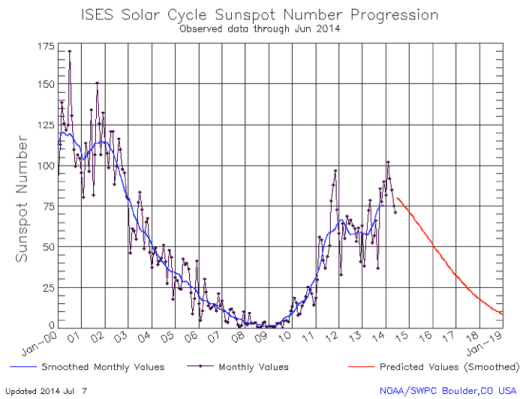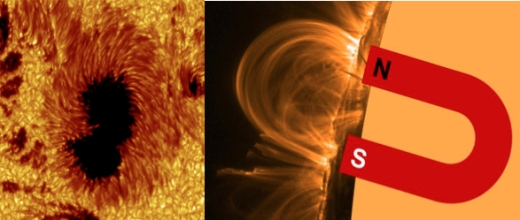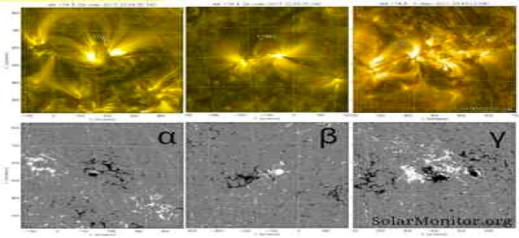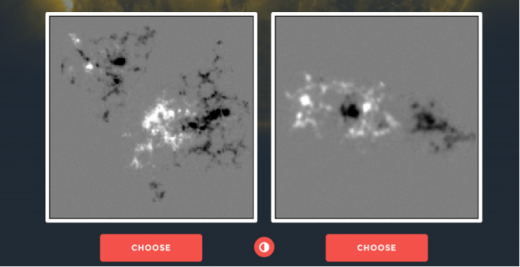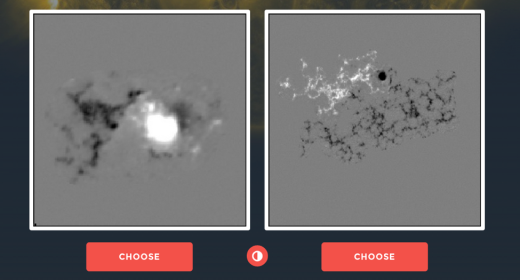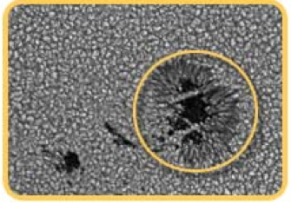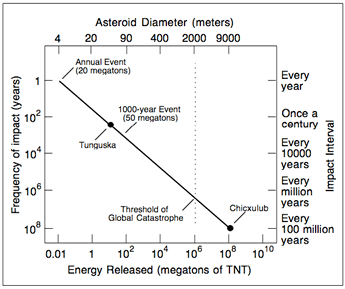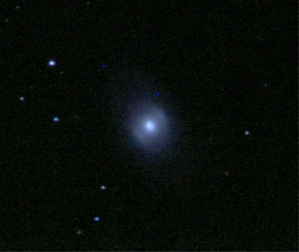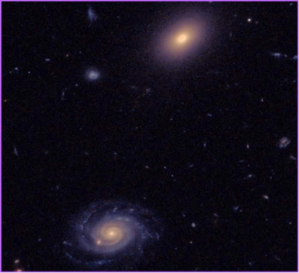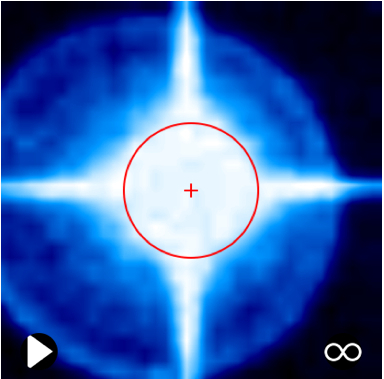by Zachary Lee and Darshan Chakrabarti
Adler Zoo Nyverse: Greetings! Welcome back to the second post of a 4 week mini-series dedicated to exploring Radio Galaxy Zoo. My name is Adler Zoo Nyverse, and I will be your host for these next couple of weeks. After an amazing introduction on difficult concepts such as gravity and escape velocity (not to mention the stellar explanation of the Radio Galaxy Zoo citizen science project), it is my pleasure to once again welcome Professor Hubble and Professor Kepler. Gentlemen, welcome, and thank you for being with us today.
P. Kepler: The pleasure is all mine.
P. Hubble: Likewise.
Adler Zoo Nyverse: Today we are going to do something a little different. Rather than explore a new concept, today we will taking questions from the audience and having you answer them. Does that sound alright?
P. Kepler: Yes!
Adler Zoo Nyverse: Excellent! Our first question comes from Mr. Dark Matter who unfortunately could not be located. Why does it look like some black holes appear to have one jet while others have two?
P. Kepler: Surprisingly, such a statement is not the case. While some images in the simulation on Radio Galaxy Zoo LOOK like they only have one jet ( like in this image for example):

© Radio Galaxy Zoo 2014
P. Kepler: In actuality, they always have two jets. It is all a matter of perspective. If you are staring directly at the “face” of a jet so to speak, then you will only see one jet. If you are staring at a side view of the galaxies and jets, then you will see two jets such as this:
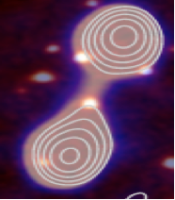
© Radio Galaxy Zoo 2014
P. Hubble: However, Mr. Dark Matter does pose an interesting question. Perspective is an important factor when classifying black holes and even more so as you look at radio and infrared images on the Zooniverse site. It is important to remember that one must consider looking at things from all perspectives.
P. Kepler: This artist’s illustration below of jets originating from a galaxy is a perfect example of what Professor Hubble said about perspective:

P. Hubble: For some of the images on the Zooniverse site, you are staring at the galaxy face-on and thus, you only see the top jet. However, having seen the artist’s illustration, you know that there are always two jets.
Adler Zoo Nyverse: Why that point actually leads us to our next question! Ms. Chandra, please enlighten us.
Ms. Chandra: While I was hunting for black holes on the Radio Galaxy Zoo site, an interesting question struck me: the galaxies that hosted black holes and jets seemed like they were relatively close to one another. Then I began to wonder whether or not the black holes could affect each other’s properties. I know I could have used the Talk page but I wanted ask you smart scientists. I know that galaxies with black holes must be far away from each other… right?
P. Kepler: You are correct. The galaxies and their central black holes actually are far apart. You must remember that images we see are in 2D. Because images are in 2D, the third dimension is lost when you are looking at the picture. This figure below, for example, shows that constellations are formed from stars that sit at different distances from each other, as opposed to stars that are the same distance from the Earth. So the stars in a constellation look much closer to each other than they really are, it’s the same for these galaxies.
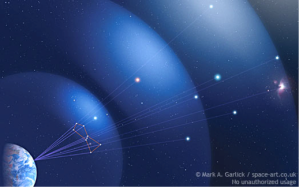
© Space Art
Ms. Chandra: Wait what about my question? I saw this a picture of a “cluster” of black holes.
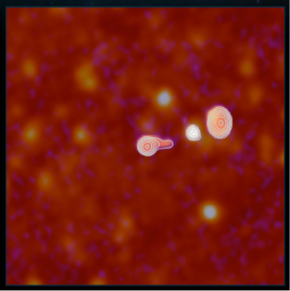
© Radio Galaxy Zoo
P. Hubble:
So besides for the fact that these galaxies could all sit at different distances from Earth, is also important to remember that when an image of Radio Galaxy Zoo is taken, the image encompasses a huge distance. This distance is much much larger than what you might think. So while, in the image above, it looks like the three black holes are relatively close to each other, they are very far apart.
P. Kepler:
And even if the galaxies were the same radial distance from the Earth, the image’s width covers a vast distance, so even a small distance on the image scales up to a prodigious distance in space. For example, the distance to most of the galaxies in the images used in the Radio Galaxy Zoo project is more than 10^22 miles away.
If everything in the image is considered to approximately be the same distance from us, then we can think of the image as a triangle, where the viewing angle is the angle opposite the base, letting the base represent the image. The viewing angle of the images used in Radio Galaxy Zoo is approximately 180 arcseconds where an arcsecond is 1/3600th of a degree. By comparing this to the minimum distance of the galaxies in the images in the Radio Galaxy Zoo project we can determine the minimum physical width of the images:

The angle of viewing in these images is about one twentieth of a degree. Using basic trigonometry, we can deduce that the width covered in these images is approximately 8.727 × 1018 miles. This is the same a a chain of about 50 milky ways or about 1011 times the distance between and the earth of the sun.
Adler Zoo Nyverse: Now we have a question from little Timmy, who is an avid reader but is not able to be here with us today because it is past his bedtime. Timmy was wondering whether or not black holes had the superpower to combine into a super duper black hole.
P. Hubble: Galaxies can grow by merging with one another (a process called galaxy merging; you can check out another Zooniverse project entitled Galaxy Zoo to learn more about this effect). Now if two galaxies are in the process of merging and there are black holes in the center of both of those galaxies, the black holes will be sufficiently close to each other to experience a significant force from each other’s gravity; the black holes will spiral towards each other and get caught in each other’s gravitational orbit. The picture below details the process of this merging:
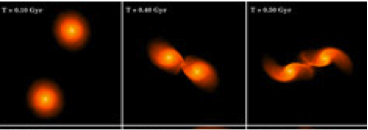

© Slac.Stanford.edu
In the first box, the two black holes are definitely separated and apart, but as the images progress, you see how the gravitational pull of each black hole pulls the latter closer and closer, and the spirals begin to form, as they get caught in each other’s gravitational orbit. The black holes begin to absorb the stars and gas and by doing so, they exert frictional force, which is a force that resists the relative motion of two materials sliding against each other. By doing so, this force takes away energy from the separate orbital motion between the two black holes, and thus the distance between the two black holes decreases. Eventually the two bodies merge and become one as the distance between them decreases.
P. Kepler:The black holes orbit each other and lose orbital energy by emitting strong gravitational waves, and this causes their orbits to shrink. Einstein’s theory of relativity states that when when two very massive objects (like black holes) are caught in orbit, they will generate gravitational waves. These waves carry energy away from the orbiting bodies (of the galaxies) and radiation of gravitational waves is associated with a decrease in orbit so with each successive revolution, the black holes get closer. As the orbit gets smaller, the two bodies merge. When the bodies become one, it is called a binary black hole. Finally, here is a picture of the process in motion:

© NASA Images
Adler Zoo Nyverse: I would like to thank all you inquisitive readers for these wonderful questions. In our next installment, expect more clever questions, more excitement, and the continuing of a journey through Radio Galaxy Zoo.
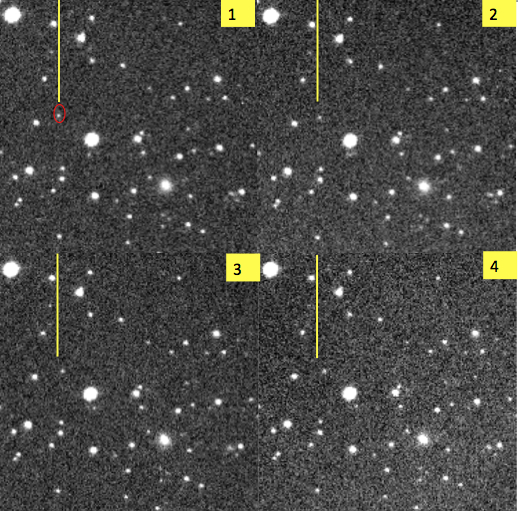 Note: The figure shows four different pictures from Asteroid Zoo that capture the movement of an asteroid. Looking from figure one through four, the asteroid moves towards the right. The red circle in the first frame outlines the moving asteroid. The yellow line stays in the same position so it can help you keep track of the moving asteroid.
Note: The figure shows four different pictures from Asteroid Zoo that capture the movement of an asteroid. Looking from figure one through four, the asteroid moves towards the right. The red circle in the first frame outlines the moving asteroid. The yellow line stays in the same position so it can help you keep track of the moving asteroid.
